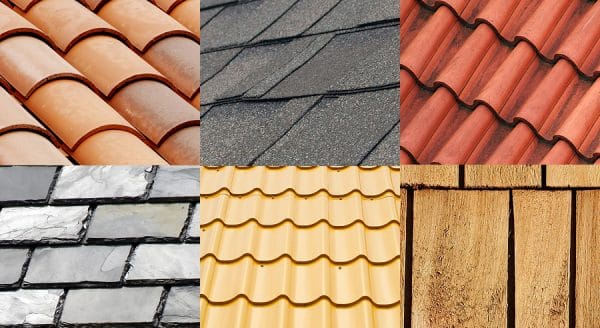
Time and weather elements take a toll on roofs, eventually requiring replacement, but choosing new roofing material requires more than just picking something that looks good. Several factors go into choosing between the various types of roofing materials. Different types of roofs and roof angles play a role in selecting the best options for your roofing project.
Understanding the pros and cons of each roofing material and how those features fit with the type of roof on your home helps you narrow down the options.
Roofing Considerations
You know looks aren’t everything, but what does matter when it comes to choosing roofing materials? The features of your home, and in particular your roof, play a role in the material that will work best. Here are some considerations when choosing materials for various types of roofs:
What are the environmental or climate issues that might affect the type of roofing material? Hurricanes, wildfires, snow and salty air are examples. A local roofing expert is a great resource for recommending materials suitable for your specific location.
How much weight can your existing roof hold? Some materials, such as slate, are very heavy and need a strong support system to work. This may require additional reinforcements for proper installation.
Is the roof’s slope steep or low? Certain roofing materials won’t work on a roof with a very low or very steep roof.
What style of roof does your home have?
What is the existing roofing material? Does that material fit your needs? If you aren’t happy with the durability or look of your current roofing material, explore the other options to see if they are a good fit for your roof type.
What is the expected life span of the materials you are considering? Choosing a material with a long life span saves you money overall and keeps your roof looking great, which boosts your overall curb appeal.
What type of maintenance does the material require? Are repairs easy, or do you have to replace the entire roof if something goes wrong?
What is your budget? Keep in mind that a new roof is an investment. Spending a little more upfront can save you money in the long run by giving you a long-lasting durable roof.
Type Of Roof Material
Basic Roof Styles
A roof is a roof, right? If you look closely, you’ll notice that not all roofs look the same. Several distinct roof styles offer different looks for homes. The type of roof you have can affect the best type of roofing material for your needs.
If you’re not sure what type of roof you have, review these basics before choosing a roofing material:
- Gable Roof: Perhaps the most basic of roof styles, the gable roof features a basic triangular look with two sides forming a shape similar to an upside down V. A variation is the crossed gable roof, which has two different gable sections running perpendicular to each other. Some homes may also have a front gable roof, with a separate gable section over the front door.
- Hip Roof: Another common residential roof style, the hip roof features four sloping sides instead of the two sides on a gable roof. Those four sides meet at the top to form the ridge. This style of roof may be either square or rectangular and offers more stability than gable roofs.
- Flat Roof: Homes with flat roof types are easy to spot. The roof has little or no pitch, giving it a flat appearance. While more popular on commercial buildings, some residential roofs also have the flat style. This style of roof requires specific materials to create a waterproof covering, since water doesn’t run off easily.
- Shed Roof: This style is similar to a flat roof, but it usually has a bit more slope.
- Gambrel Roof: The gambrel roof is the style you most typically see on a barn, but some styles of homes use this option as well. The two-sided style has two different slopes on each side. The top portion has a shallow slope, which transitions to a very steep slope on the lower portion. This type of roof can be tricky since it has two different slopes, which may be better suited to different types of roofing.
- Mansard Roof: A mansard roof is similar to a gambrel roof, except it has four sides instead of only two. Each of the four sides still has a shallow slope at the top followed by a steep slope at the bottom.
- Bonnet Roof: This roof style takes the opposite approach of the mansard. Each roof side has two slopes, with a steep upper slope and a small shallow slope at the bottom. That lower shallow slope hangs out over the sides.
- Saltbox Roof: The saltbox roof features two sides, each side a different size and sometimes with different slopes. One side is generally much longer than the other, with a steep slope.
Roof Slopes
The slope of your roof is another important factor in choosing your new roofing material. The style of roof often plays a role in the steepness of the slope. For example, gambrel roofs often have a very steep slope on the lower portion. However, there is some variation in the steepness within each style. One hip roof might have a steeper slope than another hip roof down the street, for example.
The slope of a roof is represented by a ratio to show how many inches the roof rises for each foot of run. A roof that rises 6 inches over every 12 inches of run has a 6 in 12 slope, also written as 6:12. You don’t need to know the exact slope of your roof to choose roofing material, but it does give a general idea of the special needs for your roof.
Each type of slope requires special considerations when choosing roofing material. Here are some general guidelines for each type of slope:
Steep Roof Slopes: Steep roofs have a slope between 9:12 and 21:12. Most types of roofing work on these steeper roof slopes, but they may require different installation procedures. These roofs often require special safety gear, as they are too steep for walking.
- Conventional Roof Slopes: A conventional roof slope ranges from 4:12 to 9:12. These roofs generally have a noticeable slope but still allow you to walk on them.
- Low Roof Slopes: The low slope category generally ranges from 2:12 to 4:12 ratio. Roll roofing often works best on roofs with a low slope to prevent water from leaking through the roof.
- Flat Roofs: Flat roofs encompass slopes under 2:12. Roofs typically have at least a slight slope, even if they look flat, to help shed water.
Another factor to consider based on slope is the cost of the roofing project and the scope of the installation. A roof with a steeper slope has more surface area to cover than a lower slope. That increases your materials cost for the project. When you choose an already expensive material, the cost increases even more. Labor prices may also increase on an extremely steep roof. A steep slope requires more careful installation and sometimes additional safety gear.
Asphalt Shingles
Asphalt shingles claim the title as the most popular residential roofing material. In fact, about 80 percent of U.S. homes feature asphalt shingles. That popularity stems from the affordability and the ease of installation, as well as the versatility of asphalt.
Asphalt offers a wide range of colors and styles, including both the traditional three-tab shingle design and thicker architectural shingles, which consists of several layers laminated together. The laminated architectural shingles appeal to homeowners due to the additional thickness and texture that make them stand out more than traditional thinner asphalt. The variety of styles available make asphalt shingles suitable for a variety of home styles.
Consider these factors about asphalt shingles:
- Longevity: Expect asphalt shingles to last anywhere from 15 to 50 years, depending on the quality and the environment and conditions of your area.
- Compatible Architectural Styles: Asphalt shingles work with almost any architectural style due to the variety of colors and looks. This type looks good on everything from Victorian to modern homes. The option of architectural shingles makes it easier to find a style that works with the specific design and look of your home.
- Compatible Roof Types: Asphalt also works on almost any type of roof with a slope, including gable, hip, bonnet and saltbox roofs. These shingles are not suitable for roofs with little to no slope, as they do not create a waterproof barrier. Asphalt works best on roofs with a pitch between 4:12 and 21:12. Slopes between 2:12 and 3.9:12 may work with asphalt shingles with special application procedures, but asphalt won’t work for roofs under 2:12.
Slate
A slate roof offers long-lasting beauty on your roof with impressive durability and a high resistance to fire. The roofing comes from slate cut into thin, flat sheets for smooth installation. Slate is one of the most expensive options, but the longevity of the roofing means with proper installation and care it should last a lifetime. The beauty of natural slate also makes this roofing option a strong contender for many homeowners.
Synthetic slate roofing is also available. You get the look and durability of slate in a lighter more affordable package.
- Longevity: The durability of slate means it can last 50 to 100 years or more.
- Compatible Architectural Styles: Slate works well on most architectural styles, particularly Colonial, English or French chateau styles. It tends to carry an upscale appeal, but slate can work on homes in any price range.
- Compatible Roof Types: Roofs with steep slopes work best for slate installation, as the water runs off the roof at a faster rate. A roof with a slope of 8:12 or higher — or a roof so steep you can’t walk on it — is ideal. A roof below 4:12 generally will not work with slate roofing, as it simply is not steep enough to shed water effectively.
Metal
Metal roofing offers a durable option with exceptional energy savings. Metal roofing comes at a higher price than asphalt, but the long-term investment pays off due to the long life of the metal roofing. The material stays cool with high solar reflectance and weighs less than other roofing options while standing up to weather elements. It also works well in areas with heavy snowfall, as the snow is less likely to build up on a metal roof.
Metal comes in a variety of colors and styles, making it a versatile roofing option for a variety of home styles. Standing seam and corrugated are the two primary types associated with metal roofing.
- Longevity: Metal roofs can last 50 years or longer.
- Compatible Architectural Styles: Metal works on a variety of home styles, including modern, bungalow and traditional style homes. The variety in style increases the opportunities for choosing metal, with options that replicate traditional roofing materials.
- Compatible Roof Types: Metal roofing works on gable, hip, mansard, gambrel, bonnet and flat roofs. The material typically comes in large sheets with tight seals between them, making it a versatile material for roofs with low and steeply sloped roofs.
Synthetic Rubber (EPDM)
Ethylene propylene diene monomer (EPDM), a synthetic rubber roofing material, holds up well with resistance to tears, punctures, impact, weather and UV rays, making it a durable roofing option. The single-ply membrane works well on roofs with low slopes, where traditional shingles won’t work, with the option for mechanical fastening or fully adhering the material with adhesive.
- Longevity: The life expectancy of EPDM is around 50 years, making it a lasting option.
- Compatible Architectural Styles: EPDM works with any architectural style with a flat or low slope on the roof. It is typically a very simple design.
- Compatible Roof Types: The EPDM roofing material is typically used on a flat or low-slope roof.
MODIFIED BITUMEN
Modified bitumen is a rolled roofing material ideal for roofs with a low slope. The product goes down in layers with either adhesive or a heat-welding method using a torch. Modified bitumen comes in either a smooth finish or a granulated surface similar to traditional shingles. The product comes in a variety of colors.
- Longevity: Modified bitumen can last 20 years or more with proper installation.
- Compatible Architectural Styles: Like EPDM, modified bitumen generally works on any architectural style of home with a flat or low roof. The option of a smooth or textured surface lets you choose a finish that best matches your home’s overall style.
- Compatible Roof Types: The rolled style of modified bitumen makes it ideal for low slope roofs, such as flat or shed roofs.
Putting it All Together: Choosing the Best Roofing Material
Balancing all of the factors, including roof type, home style, roof slope and budget, helps you narrow down the roofing material options for your home. If you are considering a roof replacement in Maryland, give Garner Roofing a call at 410-753-2322 or contact us online. Our professional trained staff can help you select the best roofing material for your roof type, with the quality service and products you expect.

